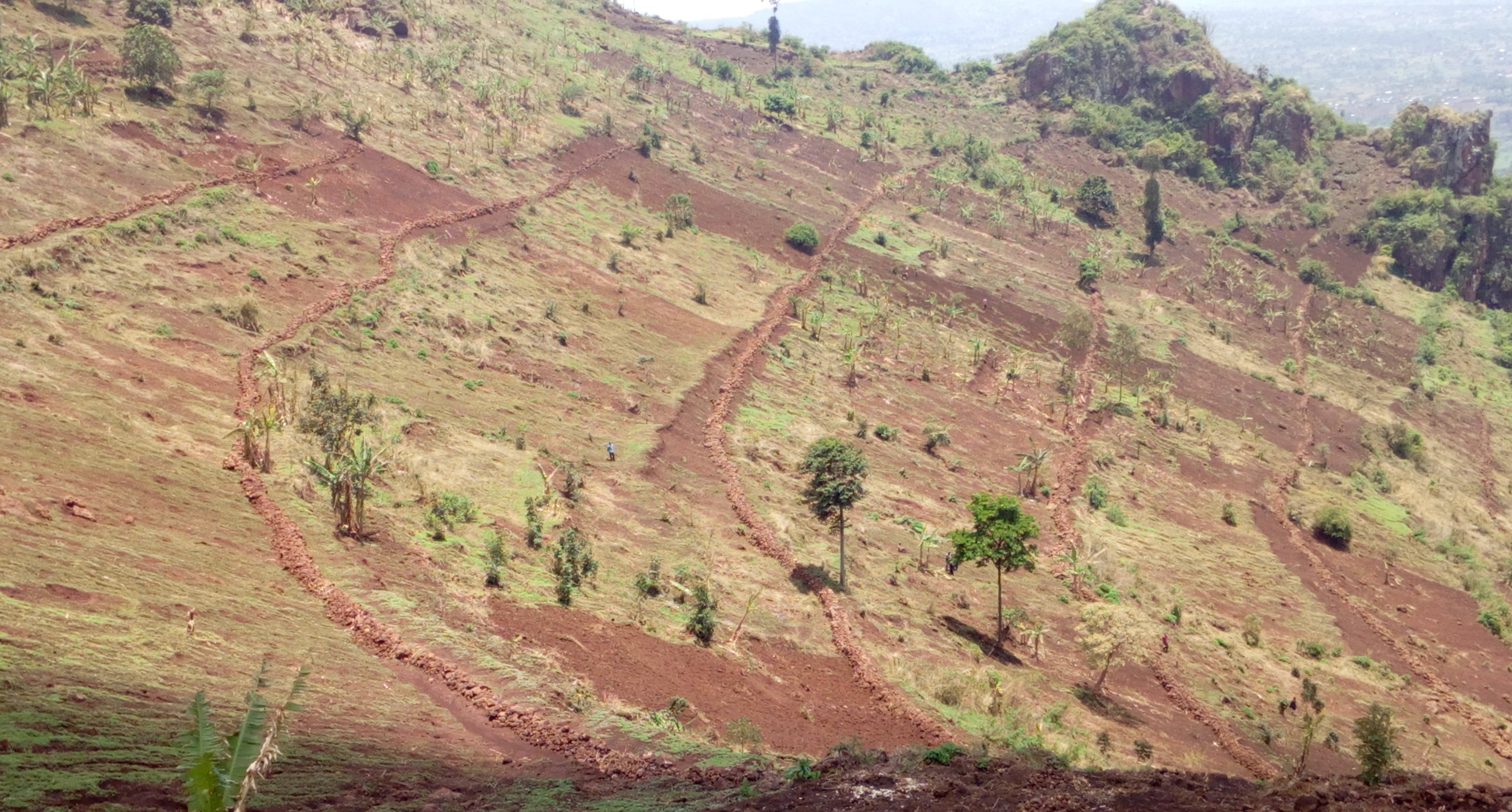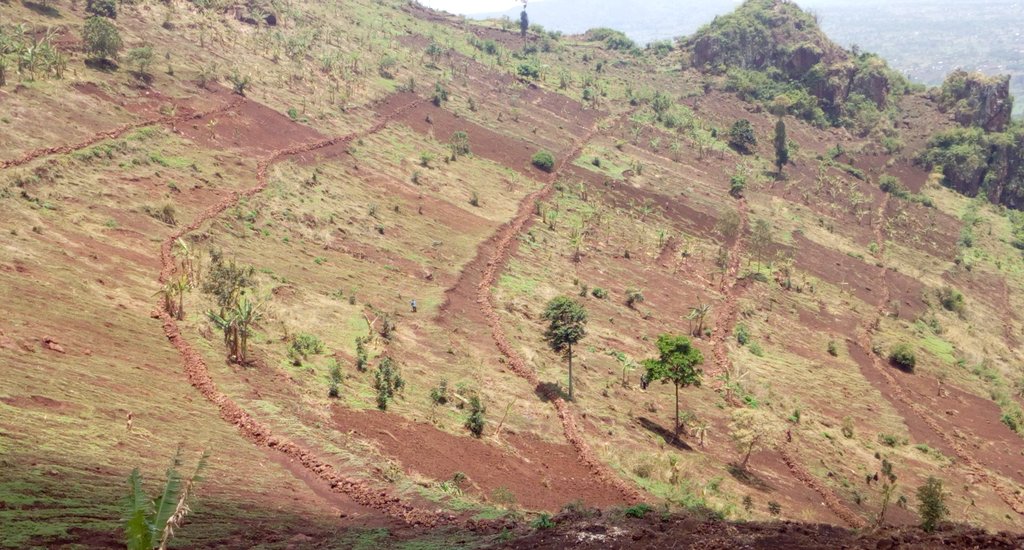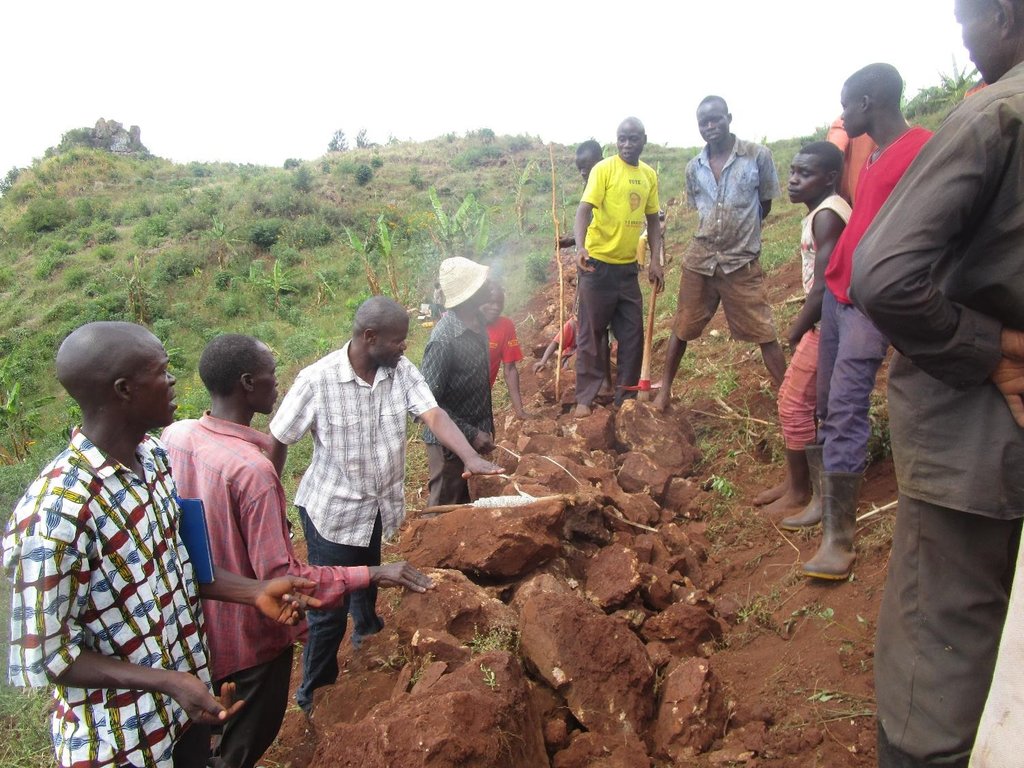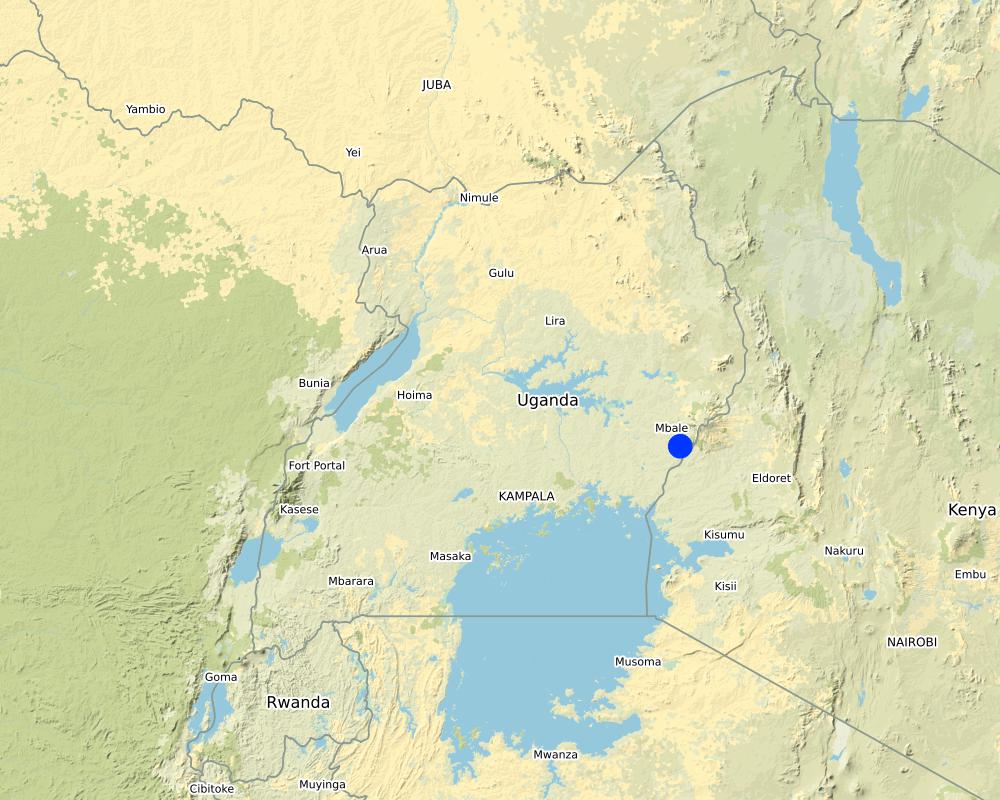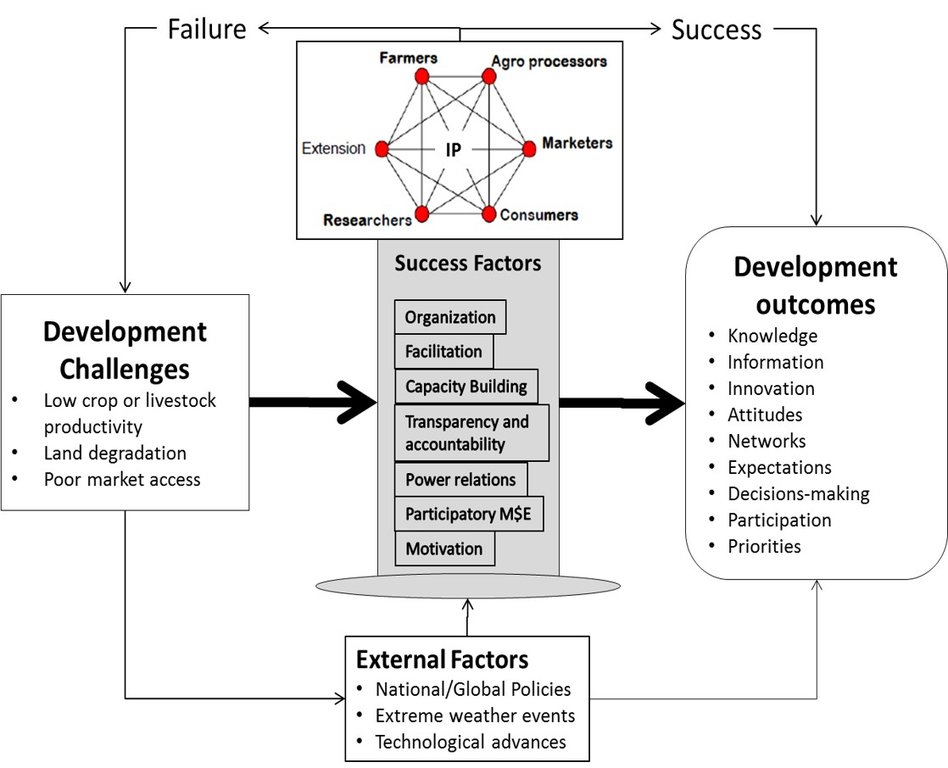Innovation Platform Approach (IPA) for Collective Action in SLM [Uganda]
- Creación:
- Actualización:
- Compilador: Bernard Fungo
- Editores: Dr. Patrick Musinguzi, Moses Makooma Tenywa, Kamugisha Rick Nelson
- Revisores: Nicole Harari, Udo Höggel
Tubaana Group
approaches_4041 - Uganda
Visualizar secciones
Expandir todo Colapsar todos1. Información general
1.2 Detalles de contacto de las personas de referencia e instituciones involucradas en la evaluación y la documentación del Enfoque
Nombre del proyecto que facilitó la documentación/ evaluación del Enfoque (si fuera relevante)
Scaling-up SLM practices by smallholder farmers (IFAD)Nombre de la(s) institución(es) que facilitaron la documentación/ evaluación del Enfoque si fuera relevante)
Uganda Landcare Network (ULN) - Uganda1.3 Condiciones referidas al uso de datos documentados mediante WOCAT
¿Cuándo se compilaron los datos (en el campo)?
12/09/2016
El compilador y la/s persona(s) de referencia claves aceptan las condiciones acerca del uso de los datos documentados mediante WOCAT :
Sí
2. Descripción del Enfoque MST
2.1 Breve descripción del Enfoque
Critical actors in a certain area come together, articulate the perceived challenge, identify solutions, allocate responsibilities and work together towards overcoming the challenge
2.2 Descripción detallada del Enfoque MST
Descripción detallada del Enfoque MST:
Efficient use of natural resources is a critical pathway to achieving green growth. Mountain ecosystems are an example of natural resources that need to be sustainably managed to continue providing economic, social and environmental benefits to the large number of dependent communities. The challenge is that these ecosystems are fragile and highly susceptible to natural disasters and their management requires multi-sectoral, transboundary, interdisciplinary and landscape level interventions. Although several technologies to address land degradation exist, adoption remains low. This has been attributed mainly to a dysfunctional extension system and weak implementation of land management policies/regulations. Working at landscape-scale and ensuring inter-sectoral coordination and cooperation is crucial for effective land management responses.
An Innovation Platform (IP) approach is a mechanism to enhance communication and innovation capacity among mutually dependent actors, by improving interactions, coordination, and coherence among all actors to facilitate learning and contribute to production and use of knowledge. The IP approach is a coalition, collaboration, partnership and alliance of agricultural research and development (ARD) actors. That is, public and private scientists, extension workers, representatives of farmers, farmers’ associations, private firms and non-governmental organizations and government policy makers.
Documentation of this approached is based on experience from a study conducted in the eastern highlands of Uganda. The aim of this study was to improve the understanding of how IPs can enhance adoption of soil and water conservation technologies in the fragile highland ecosystems of eastern Uganda. Control of soil erosion was identified as a challenge to be addressed by the IP. The process involved the key principles as follows:
1. Establishment of an effective leadership – An IP committee was established and trained on critical skills required in group dynamics
2. Facilitating formation of lower-level groups (IP clusters) – this is not a necessary step but was important to implement soil erosion control in Bugobero micro-catchments
3. Capacity building – mainly on soil erosion control using contour bunds stabilized with multipurpose trees (Calliandra and Grevillea). This was done through the Farmer Field School (FFS) approach. Farmers were able to collectively establish 4,000 meters of contour bunds and reduce run-off and erosion significantly
4. Participatory Monitoring and Evaluation
5. Development and implementation of an effective communication strategy among stakeholder; and
6. Facilitating the formulation of by-laws to foster implementation of soil erosion control. A by-law on maintenance of the established contour bunds was initiated and the process is still on-going.
From this experience, the IP intends to implement the FFS approach on other technologies such as fodder-bank establishment from Calliandra along contours bunds, manure management for production and collective marketing of bananas. These interrelated technologies are contributing towards improving the banana value chain, which plays a significant role in the food and income security of a majority of households in eastern Uganda. Data collection on information flow and knowledge sharing among stakeholders is on-going to provides empirical evidence about the potential of this approach. The benefits demonstrated by the IP are a motivation for stakeholders to participate in collective action. The cycle of benefits can lead to a self-sustaining community.
The need to establish an IP can originate from various actors including researchers, farmers, development agencies, NGOs, private companies, entrepreneurs and agricultural artisans, among others. Once a common challenge has been identified, the vision bearer can begin to mobilize other actors and share visions.
The advantages of this approach include:
1. direct and continuous interaction, communication and knowledge sharing among the IP actors
2. quick and continuous feedback from end users (farmers) at all stages of research for development and;
3. timely integration of new knowledge into the innovation process using experiential learning, monitoring and evaluation and the continous feedback
One limitation of this approach is that it requires continuous motivation of the various actors to maintain their interest the IP. Often times the benefits of Natural Ressources Management, NRM are long-lived while most actors look for shorter term benefits, making it difficult to maintain motivation. Conflict is a common occurrence in such multi-stakeholder platforms and only transparent and accountable leadership can overcome this. Examples of situation where conflict situations arise include technology selection, labour distribution, financial and gender biases.
2.3 Fotos del Enfoque
2.5 País/ región/ lugares donde el Enfoque fue aplicado
País:
Uganda
Región/ Estado/ Provincia:
Manafwa District, Mount Elgon Region
Especifique más el lugar :
Khabungu Parish, Bugobero Sub county
Comentarios:
The site is located on the southern slopes of Mt Elgon
Map
×2.6 Fechas de inicio y conclusión del Enfoque
Indique año del inicio:
2016
2.7 Tipo de Enfoque
- proyecto/ basado en un programa
2.8 Propósitos/ objetivos principales del Enfoque
Improve knowledge-sharing and dialogue among relevant actors in addressing a multi-stakeholder natural resource management challenge
2.9 Condiciones que facilitan o impiden la implementación de la/s Tecnología/s aplicadas bajo el Enfoque
normas y valores sociales/ culturales/ religiosos
- facilitan
Social capital in form of community cohesiveness encourages people to support the less-privileged such as the elderly, who cannot afford labour to construct contour bunds on their own
disponibilidad/ acceso a recursos y servicios financieros
- facilitan
Several microfinance institutions have be created with support from government of Uganda to farmer groups, although their priority is not much into natural resource management
- impiden
Stringent rules on payback periods and collateral make it difficult for most farmer groups on SLM to access
entorno institucional
- facilitan
Existence of several farmer groups can support knowledge sharing
- impiden
Enforcement of land management laws inadequate
colaboración/ coordinación de actores
- facilitan
Decentralization policy in the country
políticas
- facilitan
Decentralization policy in Uganda allows for establishment of local rules of engagement between farmers and local government
conocimiento de MST, acceso a apoyo técnico
- facilitan
Several NGOs and projects are promoting land management practices due to frequent occurrence of landslides in the area
- impiden
The largely demand-driven farmer-paid extension system in Uganda does not allow for farmers to seek technical support on land management practices
mercados (para comprar insumos, vender productos) y precios
- facilitan
Increasing population in has driven up the demand for food and agricultural supplies and this creates new markets for farmers' produce
- impiden
The difficult terrain makes access to markets terribly difficult for farmers
carga de trabajo, disponibilidad de mano de obra
- impiden
Shortage of labor due to youth migration to urban areas yet land management technologies are labor intensive
3. Participación y roles de las partes interesadas involucradas
3.1 Partes interesadas involucradas en el Enfoque y sus roles
- usuarios locales de tierras/ comunidades locales
Farmers
Implement land management practices on their farms
- especialistas MST/consejeros agrícolas
Agricultural Extension staff
Provide technical advise to farmers
- investigadores
National Agricultural Research Organization (NARO)
Study the technological, institutional and market approaches and processes for improving the functioning of the IP approach
- ONG
Mbale Coalition Against Poverty (Mbale-CAP)
Provision of farm inputs such as tree seedlings of appropriate species
- sector privado
Input dealers, product dealers and banks
Provision of input such as seedlings to farmers and buying of produce such as bananas from farmers. Banks provide low-interest loans to farmers.
- gobierno local
Sub county local government
Support the process of preparation and enactment of by-laws of land management
- organización internacional
International Research Centers (e.g. World Agroforetry Center)
Support research by providing extra expertise to national research centers and sometime laboratory facilities where needed
Si varias partes interesadas estuvieron involucradas, indique la agencia principal:
National Forestry Resources Research Institute (NaFORRI), National Agricultural Research Organization (NARO)
3.2 Involucramiento de los usuarios locales de tierras/ comunidades locales en las distintas fases del Enfoque
| Involucramiento de los usuarios locales de tierras/ comunidades locales | Especifique quién se involucró y describa las actividades | |
|---|---|---|
| iniciación/ motivación | apoyo externo | Some groups had already initiated some actions but were not very progressive. A research team came from the the National Research Institute to stimulate the organization of the group on soil erosion control. |
| planificación | interactivo | Farmers participated in the elections to establish the steering committee of the IP. They also participated in the visioning and articulation of the soil erosion challenge and the means to address it. Farmers also participated in the selection of technological options for soil erosion control. |
| implementación | interactivo | Local leaders (Local Councils) participated in the formation of lower level IP clusters in each sub catchment and mobilizing households to participate in joint activities on designated days. Farmers participated in the collective action to establish soil erosion control structures across the landscape. |
| monitoreo y evaluación | interactivo | Farmers and local leaders were part of the monitoring and evaluation committee of the IP and participated in periodic activities to asses progress towards the set targets such as the extent and quality of contour bunds completed, the rate of soil erosion and the performance of the crops after the bunds are created. |
3.3 Flujograma (si estuviera disponible)
Descripción:
Flow Chart of the process that the IP approach needs to go through to be effective
Autor:
Bernard Fungo
3.4 La toma de decisiones en la selección de Tecnología(s) MST
Especifique quién decidió la selección de las Tecnología/ Tecnologías a implementarse:
- todos los actores relevantes, como parte de un enfoque participativo
Explique:
Several meetings are held in which all actors deliberate the technological options available and a voting stage decides which of the options is to be selected for implementation. There are also situations when more than one option is considered if they do not contradict.
Especifique las bases que sustentaron la toma de decisiones:
- la evaluación de conocimiento MST bien documentado (la toma de decisiones se basa en evidencia)
- la experiencia personal y opiniones (no documentadas)
4. Apoyo técnico, fortalecimiento institucional y gestión del conocimiento
4.1 Construcción de capacidades / capacitación
¿Se proporcionó la capacitación a usuarios de tierras/ otras partes interesadas?
Sí
Especifique quién fue capacitado:
- usuarios de tierras
Forma de capacitación:
- áreas de demostración
Temas avanzados:
Soil erosion control using contour bunds, types of bunds, size and spacing between them
4.2 Servicio de asesoría
¿Los usuarios de tierras tienen acceso a un servicio de asesoría?
Sí
Especifique si servicio proporcionado se realizó:
- en los campos de los usuarios de tierras
- en centros permanentes
Describa/ comentarios:
Where the demonstration lots are established, technical staff visit the site and provide support on-site. The zonal research center is also available for interested farmers to visit and learn more about the technological options suitable for the area.
4.3 Fortalecimiento institucional (desarrollo institucional)
¿Se establecieron o fortalecieron instituciones mediante el Enfoque?
- sí, moderadamente
Especifique el nivel o los niveles en los que se fortalecieron o establecieron las instituciones:
- local
- nacional
Describa la institución, roles y responsabilidades, miembros, etc.
National Agricultural Advisory Services (NAADS) operates at district level through formation and training of farmers groups. Mainstream extension workers at the sub-counties provide training to farmers and farmers groups that are not part of the NAADS groups. The training was augmented by NARO and other NGOs.
Especifique el tipo de apoyo:
- construcción de capacidades/ entrenamiento
- equipo
Proporcione detalles adicionales:
The IP actors, including local government staff, farmer groups and extension staff were trained on various aspects of group dynamics in order to improve their management skills. The sub-county local government was provided with tools (pangas, mattocks and hoes) for use in establishing stone lines.
4.4 Monitoreo y evaluación
¿El monitoreo y la evaluación forman parte del Enfoque?
Sí
Si respondió que sí, ¿la documentación se utilizará para monitoreo y evaluación?
No
4.5 Investigación
¿La investigación formó parte del Enfoque?
Sí
Especifique los temas:
- sociología
- economía/ marketing
- tecnología
Proporcione detalles adicionales e indique quién hizo la investigación:
One of the objectives of the research was to understand how the IP processes can be improved to achieve more positive development outcomes (e.g. knowledge, attitude change). The other objective was to find out how effective short-rotation shrubs would perform in stabilizing contour bunds for soil erosion control in hillsides. The economic study aimed at assessing the marginal income from establishing contour bunds for soil erosion control.
5. Financiamiento y apoyo material externo
5.1 Presupuesto anual para el componente MST del Enfoque
Si no se conoce el presupuesto anual preciso, indique el rango:
- 2,000-10,000
Comentarios (ej. fuentes principales de financiamiento/ donantes principales):
Support from Global Environmental Facility (GEF), through NARO
5.2 Apoyo financiero/material proporcionado a los usuarios de tierras
¿Los usuarios de tierras recibieron financiamiento/ apoyo material para implementar la Tecnología/ Tecnologías? :
Sí
Si respondió sí, especifique el tipo o los tipos de apoyo, condiciones y proveedor(es) :
Tools and implements for establishing contour bunds (hoes, pangas, mattocks)
5.3 Subsidios para insumos específicos (incluyendo mano de obra)
- ninguno
Si la mano de obra de usuarios de tierras fue un insumo sustancial, ¿fue:
- recompensado con otro tipo de apoyo material?
Comentarios:
Each household owning land in the micro catchment was allowed access to the tools whenever needed. The tools were stored in a joint place where all farmers in the micro-catchment would have access to.
5.4 Crédito
¿Se proporcionó crédito bajo el Enfoque para actividades MST?
No
5.5 Otros incentivos o instrumentos
¿Se usaron otros incentivos o instrumentos para promover la implementación de Tecnologías MST?
No
6. Análisis de impacto y comentarios de conclusión
6.1 Impactos del Enfoque
¿El Enfoque empoderó a los usuarios locales de tierras, mejoró el involucramiento de las partes interesadas?
- No
- Sí, un poco
- Sí, moderadamente
- Sí, mucho
Training provided on technological options for soil erosion control and leadership training to local leaders. All stakeholders contributed to the selection of appropriate technologies.
¿El Enfoque facilitó la toma de decisiones basada en evidencia?
- No
- Sí, un poco
- Sí, moderadamente
- Sí, mucho
Farmers were part of the establishment of the contour bunds and also part of the M&E committee. Field days organized were used to show evidence of effectiveness of contour bunds at landscape level.
¿El Enfoque ayudó a los usuarios de tierras a implementar y mantener Tecnologías MST?
- No
- Sí, un poco
- Sí, moderadamente
- Sí, mucho
Farmers were able to establish 4000 meters of contour bunds in one of the micro catchments
¿El Enfoque mejoró la coordinación e implementación efectiva en costos de MST?
- No
- Sí, un poco
- Sí, moderadamente
- Sí, mucho
Various stakeholders were able to meet in one place and collectively discuss a common challenge of soil erosion
¿El Enfoque movilizó/mejoró el acceso a recursos financieros para implementar MST?
- No
- Sí, un poco
- Sí, moderadamente
- Sí, mucho
¿El Enfoque mejoró el conocimiento y capacidades de los usuarios para implementar MST?
- No
- Sí, un poco
- Sí, moderadamente
- Sí, mucho
Both the training and demonstration site on soil erosion enlightened land users about the various soil erosion control practices
¿El Enfoque mejoró el conocimiento y capacidades de otras partes interesadas?
- No
- Sí, un poco
- Sí, moderadamente
- Sí, mucho
The other stakeholders appreciated the importance of collective action at landscape level after soil erosion was reduced significantly
¿El Enfoque construyó/ fortaleció instituciones, colaboración entre partes interesadas?
- No
- Sí, un poco
- Sí, moderadamente
- Sí, mucho
Extension staff, researcher and local government were able to realize the technologies generated by NARO such as Calliandra for livestock, which had not been known to local leaders before
¿El Enfoque mitigó conflictos?
- No
- Sí, un poco
- Sí, moderadamente
- Sí, mucho
¿El Enfoque empoderó a grupos en desventaja social y económica?
- No
- Sí, un poco
- Sí, moderadamente
- Sí, mucho
¿El Enfoque mejoró la equidad de género y empoderó a las mujeres y niñas?
- No
- Sí, un poco
- Sí, moderadamente
- Sí, mucho
¿El Enfoque alentó a jóvenes/ la siguiente generación de usuarios de tierras a involucrarse con MST?
- No
- Sí, un poco
- Sí, moderadamente
- Sí, mucho
¿El Enfoque mejoró cuestiones de tenencia de tierra/ derechos de usuarios que obstaculizaron la implementación de la Tecnologías MST?
- No
- Sí, un poco
- Sí, moderadamente
- Sí, mucho
¿El Enfoque resultó en mejor seguridad alimentaria/ mejoró la nutrición?
- No
- Sí, un poco
- Sí, moderadamente
- Sí, mucho
Improvements in yield of bananas and maize was reported. This is part of food security improvement.
¿El Enfoque mejoró el acceso a los mercados?
- No
- Sí, un poco
- Sí, moderadamente
- Sí, mucho
Traders participated in the IP with the hope of accessing a steady supply of bananas at stable prices if farmers agree to sign contracts with them. This commitment was not binding and did not show much success.
¿El Enfoque llevó a un uso más sostenible/ fuentes de energía?
- No
- Sí, un poco
- Sí, moderadamente
- Sí, mucho
¿El Enfoque mejoró la capacidad de los usuarios de tierras a adaptarse a los cambios climáticos/ extemos y mitigar desastres relacionados al clima?
- No
- Sí, un poco
- Sí, moderadamente
- Sí, mucho
Before the project, soil erosion destroyed property and killed people in the catchment but this was avoided after the project implemented contour bunds. Heavy rains no longer affect the people negatively.
¿El Enfoque llevó a oportunidades de empleo, ingresos?
- No
- Sí, un poco
- Sí, moderadamente
- Sí, mucho
6.2 Motivación principal del usuario de la tierra para implementar MST
- reducción del riesgo de desastres naturales
Soil erosion used to destroy property but has now been managed by establishing contour bunds in the slopes. This is the major achievement of the project that farmers always refer to.
- conocimiento y capacidades mejorados de MST
Stakeholders were exposed to various methods of controlling run-off and soil erosion
6.3 Sostenibilidad de las actividades del Enfoque
¿Pueden los usuarios de tierras sostener lo que se implementó mediante el Enfoque (sin apoyo externo)?
- sí
Si respondió que sí, describa cómo:
After realizing the benefits, farmers can be encouraged to work together to maintain the soil erosion control structures. Local leaders can ensure that the by laws are enforced to ensure compliance by land owners.
6.4 Fortalezas/ ventajas del Enfoque
| Fuerzas/ ventajas/ oportunidades desde la perspectiva del usuario de la tierra |
|---|
| The approach ensures that every land user implements the soil erosion control structures since erosion affects everyone |
| Collective action is good because where some land users are unable to comply, either rules are enforced or they are supported to comply |
| Fuerzas/ ventajas/ oportunidades desde la perspectiva del compilador o de otra persona de referencia clave |
|---|
| Direct and continuous interaction, communication and knowledge sharing among the IP actors |
| Quick and continuous feedback from end users (farmers) at all stages of research and extension |
| Timely integration of new knowledge into the innovation process using experiential learning, monitoring and evaluation and the continual feedback from stakeholders |
6.5 Debilidades/ desventajas del Enfoque y formas de sobreponerse a ellos
| Debilidades/ desventajas/ riesgos desde la perspectiva del usuario de la tierra | ¿Cómo sobreponerse a ellas? |
|---|---|
| Sometimes some farmers do not approve of the technology being promoted and choose not to participate in collective action | Allowing for multiple options for addressing the same challenge is important in encouraging collective action |
| Lack of transparency and committed leadership can discourage participation | Capacity building on effective leadership is important |
| Debilidades/ desventajas/ riesgos desde la perspectiva del compilador o de otra persona de referencia clave | ¿Cómo sobreponerse a ellas? |
|---|---|
| It requires continuous motivation of the various actors to maintain their interest the IP. Often times the benefits of NRM are long-lived while most actors look for shorter term benefits, making it difficult to maintain motivation. | The leadership should properly articulate the short term as well as the long term benefits of the approach |
| Conflict is a common occurrence in such multi-stakeholder platforms and only transparent and accountable leadership can overcome this | Implementing the effective communication strategy is important in ensuring transparency and reducing distrust ad conflict situations |
7. Referencias y vínculos
7.1 Métodos/ fuentes de información
- visitas de campo, encuestas de campo
Up to 10 field visits over a one year period during the implementation of the proejct
- entrevistas con usuarios de tierras
A household survey of 200 households in the Bugobero sub county
7.2 Referencias a publicaciones disponibles
Título, autor, año, ISBN:
Integrated Agricultural Research for Development ...from concept to practice, ISBN: 978-9988-1-1639-0
¿Dónde se halla disponible? ¿Costo?
http://ciat-library.ciat.cgiar.org/Articulos_Ciat/biblioteca/Integrated_agricultural_research_for_development_from_concept_to_practice.pdf
7.3 Vínculos a la información relevante disponible en línea
Título/ descripción:
Guidelines for innovation platforms: Facilitation, monitoring and evaluation
URL:
http://citeseerx.ist.psu.edu/viewdoc/download?doi=10.1.1.856.4244&rep=rep1&type=pdf
Vínculos y módulos
Expandir todo Colapsar todosVínculos
No hay vínculos
Módulos
No se hallaron módulos


